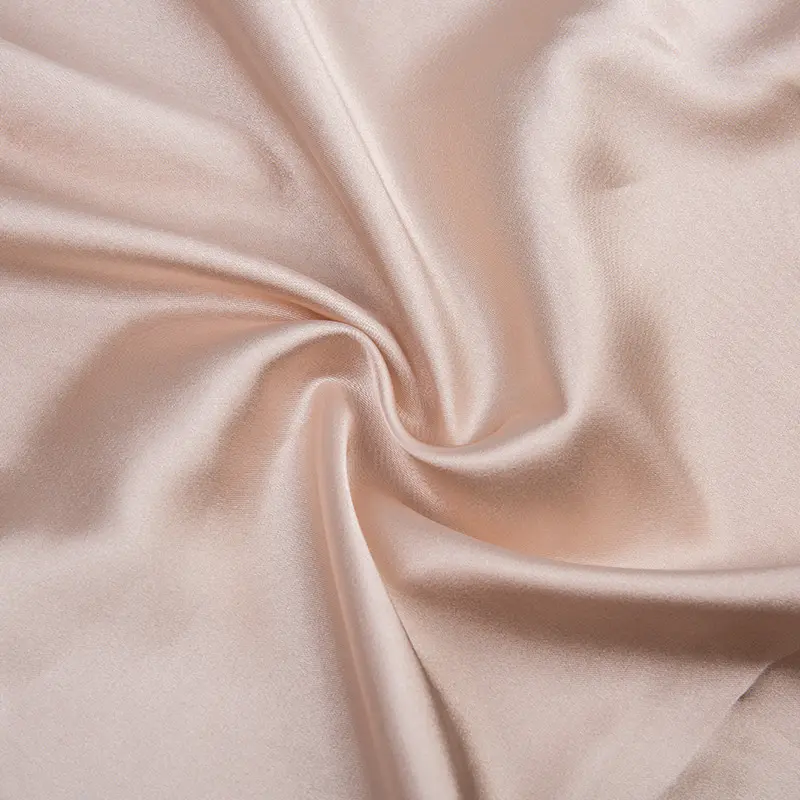 2024.12.26
2024.12.26
 Industry news
Industry news
1. Production of synthetic fibers and their high energy consumption
One of the most common raw materials for Imitated Silk Fabric is synthetic fibers, especially polyester (polyethylene terephthalate, PET). Polyester fibers play an important role in global textile production and are one of the most common ingredients in imitation silk fabrics. The production of polyester fibers requires multiple steps, including polymerization, melting, spinning, stretching and other processes, which require a lot of energy.
Polymerization: The production of polyester starts with the chemical reaction of two raw materials, terephthalic acid (PTA) and ethylene glycol (EG), which usually occurs under high temperature and pressure. In order to achieve the high temperature required for polymerization (about 270°C to 280°C), a large amount of energy supply is required, mainly coal, natural gas or electricity. The energy consumption of this link accounts for the largest part of the entire production process.
Melting and spinning: After the polymerization reaction, the polyester resin needs to be melted and stretched into fibers. This process requires high-temperature melting equipment (usually between 250°C and 300°C), and the stretching process requires sufficient power through mechanical equipment, which further consumes a lot of energy. The heating equipment and cooling equipment used in the melt spinning process are also key links in energy consumption.
Post-processing and dyeing: After the polyester fiber is produced, it needs to be dyed and finished. Hot water and high-temperature steam are usually used in the dyeing process, which not only consumes a lot of heat energy, but also consumes water resources. Textile dyeing is an energy-intensive process, especially for the use of dark dyes, which often requires higher temperatures and longer processing time.
The production of synthetic fibers is not only energy-intensive, but many steps are inevitably accompanied by the emission of carbon dioxide (CO₂) and other greenhouse gases, which is also an important cause of global climate change. The high energy consumption of polyester fiber production has become a focus of attention for many environmental organizations and regulatory agencies.
2. Energy consumption in the production process of natural fibers (such as rayon)
Rayon, especially fibers produced by solvent spinning (such as Tencel Tencel), usually uses natural materials such as wood pulp, bamboo pulp, etc. as raw materials. Although this production method is more environmentally friendly than synthetic fibers, it still faces the problem of energy consumption.
Pulp processing and fiber dissolution: The production of rayon first requires the processing of wood pulp into a cellulose solution. This process usually requires the dissolution of wood pulp by chemical solvents (such as copper chloride, ammonia, etc.), which consumes a lot of chemicals and energy. The use of water vapor and heat energy is essential during the dissolution process, especially when the solution needs to be heated or evaporated at high temperatures. Although the energy consumption in the solvent spinning process is lower than that of synthetic fibers, this link still requires considerable power and heat support.
Spinning and stretching: Similar to polyester fibers, rayon fibers also need to be spun by melt or solvent spinning. During the spinning process, high-efficiency mechanical equipment and electricity are relied on to complete the stretching and shaping of the fibers. Some production methods also require high-temperature treatment or heating to ensure the strength and elasticity of the fibers, which increases energy consumption.
Post-processing process: Similar to the production of synthetic fibers, rayon also consumes a lot of energy in post-processing processes such as dyeing, finishing, and shaping. Although rayon is more biodegradable than polyester, its production process still consumes a lot of water, electricity and steam, especially in the later dyeing and washing stages.
3. Environmental impact of energy consumption
The high energy consumption generated during the production process not only directly affects the production cost, but also has serious environmental impacts. The following are several specific manifestations:
Greenhouse gas emissions: Excessive energy consumption, especially when using fossil fuels (such as coal and natural gas), will produce a large amount of carbon dioxide emissions, which exacerbates global warming and climate change. The textile industry is the second largest industrial emission source in the world, mainly due to the large amount of energy consumption in its production process.
Resource waste: Large-scale energy consumption inevitably leads to resource waste, especially in some high-energy-consuming links, where energy use is inefficient. Excessive consumption of electricity and fuel may lead to resource depletion and put pressure on the global energy supply system.
Water resource consumption and pollution: The production process of many imitation silk fabrics requires a large amount of water resources, especially in the dyeing, washing and post-processing stages. Water resource waste and pollution may burden the local environment, especially in areas with scarce water resources.
4. Solutions to reduce energy consumption
Faced with the high energy consumption in the production process of imitation silk fabrics, many companies and industry organizations are looking for more environmentally friendly solutions.
Use renewable energy: More and more textile mills are turning to renewable energy such as solar energy and wind energy to replace traditional fossil fuels. This not only reduces carbon emissions, but also reduces energy costs and improves sustainability in the long run.
Improve energy efficiency: By optimizing production processes and adopting advanced equipment and technologies, energy consumption can be greatly reduced. Utilize waste heat recovery systems and finely manage energy use to reduce ineffective energy consumption in the production process.
Circular economy model: Promote the use of fiber recycling technology and recycled fibers. Polyester produced from recycled materials (such as rPET) can greatly reduce the demand for new materials, thereby reducing energy consumption in the production process.
